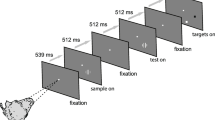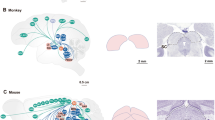Abstract
In cats, the postero-medial part of lateral suprasylvian cortex (PMLS) is generally considered a key area for motion processing. While behavioral studies have indeed supported the role of PMLS cortex in higher order motion integration (Cereb Cortex 6:814–822, 1996), there is no evidence that individual PMLS cells can perform such analysis (Vis Neurosci 5:463–468, 1990; J Neurophysiol 63:1529–1543, 1990). Given the fundamental importance of understanding the neural substrate subtending higher order motion processing, we investigated whether PMLS neurons can signal the direction of motion of complex random dot kinematograms (RDKs) wherein comprising elements do not provide any local coherent motion cues. Results indicated that most PMLS cells (82%) can integrate the displacement of individual elements into a global motion percept. Their large receptive fields allowed the integration of motion for elements separated by large spatial intervals (up to 4°). In most cases, the analysis of complex RDK motion necessitated the contribution of the area of the visual field beyond the classical receptive field. None of the complex RDK-sensitive cells were found to be pattern-motion selective when tested with plaid patterns. Our results provide the first evidence that receptive fields of PMLS neurons can perform global motion analysis and support the behavioral evidence that this area is implicated in complex motion processing (Cereb Cortex 6:814–822, 1996). It also further corroborates the findings that PMLS neurons cannot signal the true direction of a plaid pattern (Vis Neurosci 5:463–468, 1990; J Neurophysiol 63:1529–1543, 1990). Providing that these same neurons can signal the direction of complex RDKs, there may be distinct cortical mechanisms for processing different types of complex motion.









Similar content being viewed by others
References
Abramson BP, Chalupa LM (1985) The laminar distribution of cortical connections with the tecto- and cortico-recipient zones in the cat’s lateral posterior nucleus. Neuroscience 15:81–95
Adelson EH, Movshon JA (1982) Phenomenal coherence of moving visual patterns. Nature 300:523–525
Barlow HB (1972) Single units and sensation: a neuron doctrine for perceptual psychology? Perception 1:371–394
Blakemore C, Zumbroich TJ (1987) Stimulus selectivity and functional organization in the lateral suprasylvian visual cortex of the cat. J Physiol (Lond) 389:569–603
Britten KH, Newsome WT (1998) Tuning bandwidths for near-threshold stimuli in area MT. J Neurophysiol 80:762–770
Brosseau-Lachaine O, Faubert J, Casanova C (2001) Functional sub-regions for optic flow processing in the posteromedial lateral suprasylvian cortex of the cat. Cereb Cortex 11:989–1001
Castelo-Branco M, Goebel R, Neuenschwander S, Singer W (2000) Neural synchrony correlates with surface segregation rules. Nature 405:685–689
Castelo-Branco M, Formisano E, Backes W, Zanella F, Neuenschwander S, Singer W, Goebel R (2002) Activity patterns in human motion-sensitive areas depend on the interpretation of global motion. Proc Natl Acad Sci USA 99:13914–13919
Chen H, Li B, Diao YC (2004) Response properties of neurons in cat dorsal lateral suprasylvian cortex to optic flow fields. Neuroreport 15:1019–1023
Downing CJ, Movshon JA (1989) Spatial and temporal summation in the detection of motion in stochastic random dot display. Invest Ophthalmol Vis Sci Suppl 30:72
Dreher B, Djavadian RL, Turlejski KJ, Wang C (1996) Areas PMLS and 21a of cat visual cortex are not only functionally but also hodologically distinct. Prog Brain Res 112:251–276
Dumbrava D, Faubert J, Casanova C (2001) Global motion integration in the cat’s lateral posterior-pulvinar complex. Eur J Neurosci 13:2218–2226
Gizzi MS, Katz E, Movshon JA (1990a) Spatial and temporal analysis by neurons in the representation of the central visual field in the cat’s lateral suprasylvian visual cortex. Vis Neurosci 5:463–468
Gizzi MS, Katz E, Schumer RA, Movshon JA (1990b) Selectivity for orientation and direction of motion of single neurons in cat striate and extrastriate visual cortex. J Neurophysiol 63:1529–1543
Guido W, Tong L, Spear PD (1990) Afferent bases of spatial- and temporal-frequency processing by neurons in the cat’s posteromedial lateral suprasylvian cortex: effects of removing areas 17, 18, and 19. J Neurophysiol 64:1636–1651
Guo K, Benson PJ, Blakemore C (2004) Pattern motion is present in V1 of awake but not anaesthetized monkeys. Eur J Neurosci 19:1055–1066
Heuer HW, Britten KH (2004) Optic flow signals in extrastriate area MST: comparison of perceptual and neuronal sensitivity. J Neurophysiol 91:1314–1326
Huk AC, Heeger DJ (2002) Pattern-motion responses in human visual cortex. Nat Neurosci 5:72–75
Huxlin KR, Pasternak T (2004) Training-induced recovery of visual motion perception after extrastriate cortical damage in the adult cat. Cereb Cortex 14:81–90
Lehky SR, Sejnowski TJ (1990) Neural model of stereoacuity and depth interpolation based on a distributed representation of stereo disparity. J Neurosci 10:2281–2299
Li B, Li BW, Chen Y, Wang LH, Diao YC (2000) Response properties of PMLS and PLLS neurons to stimulated optic flow patterns. Eur J Neurosci 12:1534–1544
Li B, Chen Y, Li BW, Wang LH, Diao YC (2001) Pattern and component motion selectivity in cortical area PMLS of the cat. Eur J Neurosci 14:690–700
Majaj N, Carandini M, Smith MA, Movshon JA (1999) Local integration of features for the computation of pattern direction by neurons in macaque area MT. Soc Neurosci Abstr 25:674
Merabet L, Desautels A, Minville K, Casanova C (1998) Motion integration in a thalamic visual nucleus. Nature 396:265–268
Merabet L, Minville K, Ptito M, Casanova C (2000) Responses of neurons in the cat posteromedial lateral suprasylvian cortex to moving texture patterns. Neuroscience 97: 611–623
Mikami A, Newsome WT, Wurtz RH (1986) Motion selectivity in macaque visual cortex. II. Spatiotemporal range of directional interactions in MT and V1. J Neurophysiol 55:1328–1339
Miller R (1996) Cortico-thalamic interplay and the security of operation of neural assemblies and the temporal chains in the cerebral cortex. Biol Cybern 75:263–275
Minville K, Casanova C (1998) Spatial frequency processing in the posteromedial lateral suprasylvian cortex does not depend on the projections from the striate-recipient zone of the cat’s lateral posterior-pulvinar complex. Neurosciences 84:699–711
Movshon JA, Adelson EH, Gizzi MS, Newsome WT (1986) The analysis of moving visual patterns. In: Chagas C, Gattass R, Gross C (eds) Pattern recognition mechanisms. Springer, Berlin Heidelberg New York, pp 148–164
Movshon JA, Albright TD, Stoner GR, Majaj NJ, Smith MA (2003) Cortical responses to visual motion in alert and anesthetized monkeys. Nat Neurosci 6:3
Mumford D (1991) On the computational architecture of the neocortex. I. The role of the thalamo-cortical loop. Biol Cybern 65:135–145
Newsome WT, Paré EB (1988) A selective impairment of motion perception following lesions of the middle temporal visual area (MT). J Neurosci 8:2201–2211
Norita M, Kase M, Hoshino K, Meguro R, Funaki S, Hirano S, McHaffie JG (1996) Extrinsic and intrinsic connections of the cat’s lateral suprasylvian visual area. Prog Brain Res 112:231–250
Ouellette BG, Minville K, Faubert J, Casanova C (2004) Simple and complex visual motion response properties in the anterior medial bank of the lateral suprasylvian cortex. Neuroscience 123:231–245
Pack CC, Berezovskii VK, Born RT (2001) Dynamic properties of neurons in cortical area MT in alert and anaesthetized macaque monkeys. Nature 414:905–908
Pack CC, Berezovskii VK, Born RT (2003) Reply to ‘Cortical responses to visual motion in alert and anesthetized monkeys’. Nat Neurosci 6:3–4
Pasternak T, Horn KM, Maunsell JH (1989) Deficits in speed discrimination following lesions of the lateral suprasylvian cortex in the cat. Vis Neurosci 3:365–375
Pasternak T, Tompkins J, Olson CR (1995) The role of striate cortex in visual function of the cat. J Neurosci 15:1940–1950
Payne BR (1993) Evidence for visual cortical area homologs in cat and macaque monkey. Cereb Cortex 3:1–25
Raczkowski D, Rosenquist AC (1983) Connections of the multiple visual cortical areas with the lateral posterior-pulvinar complex and adjacent thalamic nuclei in the cat. J Neurosci 3:1912–1942
Rudolph KK, Pasternak T (1996) Lesions in cat lateral suprasylvian cortex affect the perception of complex motion. Cereb Cortex 6:814–822
Scannell JW, Sengpiel F, Tovee MJ, Benson PJ, Blakemore C, Young MP (1996) Visual motion processing in the anterior ectosylvian sulcus of the cat. J Neurophysiol 76:895–907
Sherk H, Fowler GA (2002) Lesions of extrastriate cortex and consequences for visual guidance during locomotion. Exp Brain Res 144:159–171
Sherman SM, Guillery RW (1996) Functional organization of thalamocortical relays. J Neurophysiol 76:1367–1395
Singer W (1994) Neurobiology. A new job for the thalamus. Nature 369(6480):444–445
Smith MA, Maja NJ, Movshon JA (2005) Dynamics of motion signaling by neurons in macaque area MT. Nat Neurosci 8:220–228
Sokal RR, Rohlf FJ (1981) Biometry, 2nd edn. W.H. Freeman, New York, pp 561–690
Spear PD (1991) Functions of extrastriate visual cortex in non-primate species. In: Leventhal AG (ed) The neural basis of visual function. Macmillan Press, London, pp 339–370
Symonds LL, Rosenquist AC, Edwards SB, Palmer LA (1981) Projections of the pulvinar-lateral posterior complex to visual cortical areas in the cat. Neuroscience 6:1995–2020
Tong L, Kalil RE, Spear PD (1982) Thalamic projections to visual areas of the middle suprasylvian sulcus in the cat. J Comp Neurol 212:103–117
Updyke BV (1981) Projections from visual areas of the middle suprasylvian sulcus onto the lateral posterior complex and adjacent thalamic nuclei. J Comp Neurol 201:477–506
Villeneuve MY, Casanova C (2001) Complex motion integration in the cat PMLS cortex. SFN Abstr 27:165.1
Villeneuve MY, Casanova C (2003) On the use of isoflurane versus halothane in the study of visual response properties of single cells in the primary visual cortex. J Neurosci Methods 129:19–31
Vinje WE, Gallant JL (2000) Sparse coding and decorrelation in primary visual cortex during natural vision. Science 287:1273–1276
Vinje WE, Gallant JL (2002) Natural stimulation of the nonclassical receptive field increases information transmission efficiency in V1. J Neurosci 22:2904–2915
Williams DW, Sekuler R (1984) Coherent global motion percepts from stochastic local motions. Vision Res 24:55–62
Wilson HR, Ferrera V, Yo C (1992) A psychophysically motivated model for two-dimensional motion perception. Vis Neurosci 9:79–97
Zabouri N, Ptito M, Casanova C (2003) Complex motion sensitivity of neurons in the visual part of the anterior ectosylvian cortex. SFN Abstr 29:179.4
Acknowledgments
This work was supported by a CIHR grant to C.C. We thank J.A. Movshon for information and formulas related to the novel method of analysis of plaid pattern responses. FRSQ provided most of C.C.’s salary (Chercheur National program). M.Y.V. was supported in part by a FRSQ—Vision Health Network Fellowship.
Author information
Authors and Affiliations
Corresponding author
Rights and permissions
About this article
Cite this article
Villeneuve, M.Y., Ptito, M. & Casanova, C. Global motion integration in the postero-medial part of the lateral suprasylvian cortex in the cat. Exp Brain Res 172, 485–497 (2006). https://doi.org/10.1007/s00221-006-0357-2
Received:
Accepted:
Published:
Issue Date:
DOI: https://doi.org/10.1007/s00221-006-0357-2




